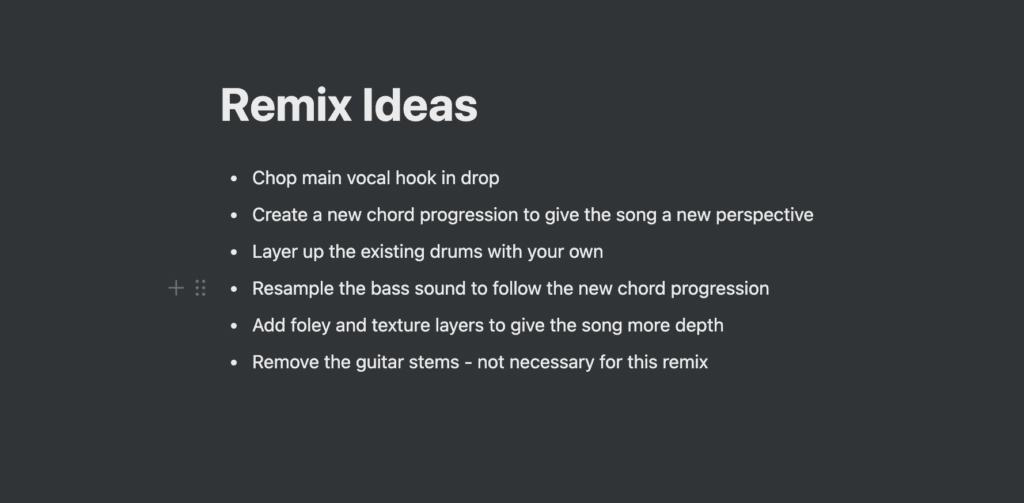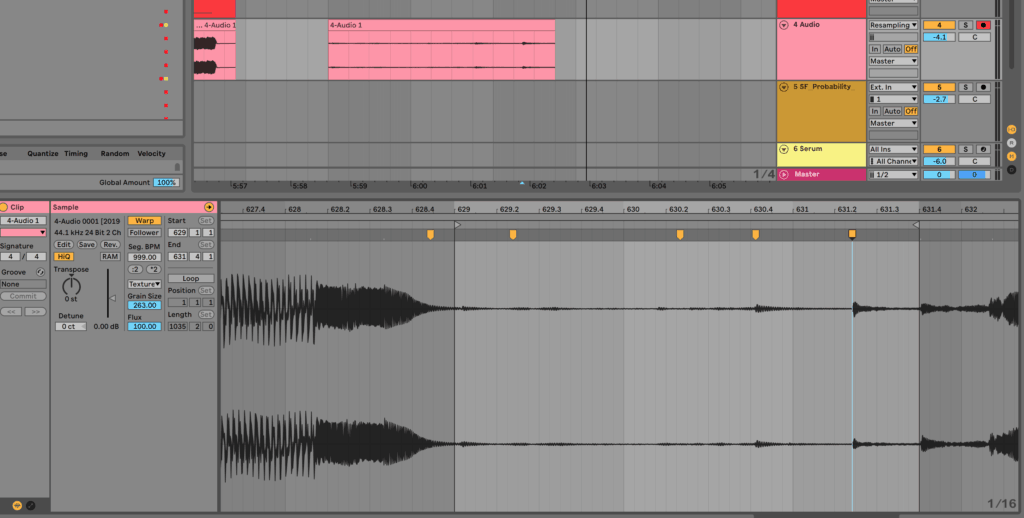You’re not the first person looking for how to remix a song. Almost every producer started their journey with remixes and bootleg.
But if you’ve never done a remix of a song before, it can all seem very confusing.
Where do you get stems? How do you arrange a remix? Is it even legal to put out a remix you’ve done?
In this guide, we’ll cover everything you need to know about how to remix a song – and much more! So let’s dive in 👇 on everything you need to know about remixing. This thing will get you set up with making remixes in no time.
Before We Get Started on How to Remix a Song
You’ve come to this article for one thing, and one thing only: learn how to remix a song. So we won’t waste your time. We’ve broken up this guide into 3 separate sections:
- different ways to approach a remix;
- practical tips you can use in your DAW when remixing a song;
- remixes and bootlegs, and what sets them apart.
How to Remix a Song: 6 Different Approaches
#1: Rewrite Chords and Melodies
Most producers approach a remix thinking about what they will keep the same.
However, why not think of your remixing in terms of what you will change?
Let’s say the vocal is the central focus of the original track. You could entirely rewrite the chord progression and melody around that vocal. This would make your remix truly unique and stand out.
Check out the track “It’s That Time” by Marlon Hoffstadt, and the remix by FISHER:
The track really centers around the vocals. All the other elements are only there to support that main vocal.
However, FISHER brought in a brand new melody in his remix.
He also changed the genre from Eurodance to Tech House (which we’ll explore in our next section). But more importantly, in the first few seconds of the track, you can immediately hear a brand new melody (which is actually also the bassline) in his remix. This gives a completely new flavor to his remix.
#2: Change Genres
This is one of the most common approaches to remixing a song.
Changing genres forces you to be creative because you normally have to solve a few problems.
For instance, if you have an acapella sitting at 130BPM that you want to use at 120BPM, you can warp it, but it might sound a bit strange. One strategy people use, especially Drum and Bass producers is to cut up the acapella without changing the tempo so that it plays on the beat.
However, you can also simply slow down or speed up the acapella – which is exactly what FISHER did in the remix he saw previously.
Let’s look at another wildly successful example: Lost Frequencies and his track “The Feeling”:
This song has 174 million streams on Spotify as of September 2024 – not bad. But let’s look at one of the remixes for this track:
This Drum and Bass remix has a cozy 28 million streams on Spotify alone – and another 5 million on YouTube.
What’s genius about this remix is that it took the original track (which is more or less Pop House), and turned it into something completely new.
By doing this, Lost Frequencies opened up his track to a whole new audience. Indeed, most DnB listeners would probably not listen to his brand of House music. But a DnB remix with touches of Jump Up? Count me in!
By remixing a song in a brand new genre, you can attract new people to it. We actually talk about this in our article on how to get more plays on SoundCloud. Let’s take a popular track currently: Charli XCX ft. Billie Eilish – GUESS. A Dubstep DJ might want a Dubstep remix of that track for his sets. By remixing popular tracks in your own genre, you can therefore attract DJs (or just fans of that genre!).

#3: Take Elements Away
Sometimes, the best thing to do is strip the elements of the original back and start with less.
Let’s say you have a remix pack with 10 different stems and 15 MIDI files. Why not pick a few instead of trying to include everything?
This goes for acapellas too. If the original features the entire vocal, why not feature just the chorus section of the vocal? Or chop up certain bits to recreate a new vocal hook?
#4: Work Around the Key Element
All good tracks will have a key element.
Often, this is a vocal. But if it’s not the vocal, it’s either the bassline or the lead melody.
Typically when you’re remixing, you want to keep this key element present. It’s what defines the track, and if you get rid of it your remix might sound too much like an original track. In other words, it won’t contain enough of the original track for people to identify it.
So, if you’re given an acapella or strong melody, use that as a basis for the track. Work around it instead of trying to fit it into an existing template.
Take this remix of Sean Paul’s Get Busy:
If the remix didn’t include Sean Paul’s signature vocals, it wouldn’t sound like a remix. It would just be an original track. How to remix a song is all about balancing the familiarity people have with the track, while also introducing them to something new.
#5: Reverse the Structure
Don’t literally reverse the structure, but try to do the opposite. If the original track features a breakdown at bar 16, make your remix have a drop at bar 16. Maybe the original has a drop at bar 32, but your remix has a breakdown at bar 32.
If the original has a 32-bar chorus and 16-bar breakdown, make a remix that has a 16-bar drop and 32-bar breakdown.
You get the idea. This is another way to reduce the likelihood of making something similar.
#6: Make Something that Contrasts in Energy
This tip somewhat overlaps with the one about changing genres. The idea here is to completely change the vibe of the track.
It’s easy to make a progressive house banger remix of a progressive house banger.
What’s more challenging and requires more creativity is turning a progressive house banger into a mellow deep house track.
One track I’ve been digging recently is the ambient remix of “Satisfied” by Catching Flies:
Contrast this remix with the original version, which is much more energetic:
Try to make something that contrasts in energy with the original. Labels typically love this as it allows them to cater to more than one audience or listening platform. If an original has high energy, make a low-energy remix, and vice versa.
Another example I’ve come across is heavy metal bands doing LoFi remixes of their tracks:
15 Practical Tips when you Remix a Song
Now that we’ve covered different ways you can approach a remix of a song, let’s dive into practical tips you can use.
#1: Pick the Right Song to Remix
Pick a song that you think would benefit from a remix. You’re more likely to follow through with the remix if you like the original song.
This is even more important if you’re making a bootleg and don’t have access to any stems; you need to pick a song that leaves room for work to be done.
Here’s a great example:
Acoustic/minimal songs are great to remix. Petit Biscuit’s ‘Sunset Lover’ has such a strong hook but a lot of creative potential, which is why there have been a few remixes of it.
#2: Listen for the Gaps
After choosing a song to remix, take a good listen to the original and write down any ideas that come to mind.
- Maybe you like the chorus but feel it needs stronger drums or a heavier bassline.
- Perhaps the verse is too long for your liking.
- You could even replace the existing melody with a more unique one.
Whatever comes to mind, write it down and take notes. You’ll use them when you start working on your remix.
#3: Form a Game Plan
Having a general plan that you can refer back to when stuck in a rut is invaluable. It helps you stay on task and work on the important. And despite what many argue, planning does not inhibit creativity!
Before starting a remix, why not do a bit of brainstorming? If you’ve got ideas from tip #2, then this is the time to write them down.
The result? You’ll sit down to produce your remix with clear intentions and objectives instead of blankly staring at the screen.
Tip: Consider the audience. If you’re trying to win a remix contest or gain attention from the original artist, think about how that should influence the remix. Are they looking for a club friendly remix, or something more radio friendly? Keeping these in mind will increase your chance of success.
#4: Cut and Choose Your Material (Bootlegs)
If you don’t have access to an acapella or any other stems, you’re going to need to identify which parts of the original track you want to, and can, use.
You’ll find that certain sections can’t be used at all, simply because there’s too much going on. I might, for example, take out the intro, outro, and choruses of an original track and only use the breakdown which contains a vocal, then build upon that.
#5: Arrange your remix ASAP
One of the main reasons people don’t finish remixes is because they don’t get the arrangement down soon enough.
As soon as you have ideas down, sketch out a basic arrangement.
You should have it down quicker than you would normally when working on an original, because you already have a few ideas handed to you.
Note: I find it helpful to drag the original track/vocal into my DAW, marking each section of the song. This way, I have the arrangement in place from the start. I may change the arrangement later on in the production process, but I benefit from building on a solid foundation.
#6: Keep it Similar
A remix doesn’t have to be incredibly contrasted to the original. Sometimes you might just want to add a little extra to the original, or expand on ideas.
For example, you’ll often hear remixes where the artist has changed just the bassline and drums, but kept the overall vibe of the song. This is the case in What So Not’s remix of ‘Major Lazer – Get Free’:
This doesn’t work for every remix, but sometimes it’s exactly what’s needed.
#7: Process and Mangle Stems
Want to impress the listener? Get creative with stems! You can make stems your own with enough processing. Reverse and chop up acapellas, apply heavy distortion to bass sounds, the possibilities are endless.
A few ideas to get you started…
- Use parts of the bass stem(s) to fill in your bassline groove.
- Chop, loop and reverse slices of the original vocal to create your own melodies and effects
- Chop one note from an instrument stem, put it into a sampler, then process it to create something that’s new yet familiar.
- Add phasing, reverb, and filtering to the main melody stem in parts of your song to tease the listener.
- Apply reverb, delay, and distortion to FX stems to significantly change their sound.
If you’re in Ableton Live, check out some of these creative tips which can be applied to processing and mangling.
#8: Collaborate
I can’t overemphasize the importance of collaboration. Not only is it ultra fun, but you learn a lot about how other people work and often end up in a more motivated and creative state than you would working by yourself.
Collaborating on a remix is just as fun, if not more fun than collaborating on an original. You’ll both have different opinions on the original track, and you’ll both come up with different ideas.
#9: Add a Second Hook to Your Remix
Does the main idea in the original track not do it for you? Too weak? Too boring?
Why not add a second hook?
Jaytech’s remix of Blood Groove and Kiki’s progressive masterpiece known as Mirage features a memorable vocal chop in addition to the serene chord progression from the original.
The original:
Jaytech’s remix with the vocal hook:
#10: Warping stems and acapella
So, let’s say you’ve downloaded an acapella that’s at 105 BPM, and you want to bring it down to 90 BPM. How do you do that in Ableton Live?
If the acapella doesn’t have any timing issues, then it’s a pretty straightforward process.

What we want to focus on is the Warp section.
My acapella is currently at 105 BPM, and I know this for a fact. If you don’t know the tempo of your acapella, a quick Google search will suffice (just type “song key bpm”).
I’ll enable warp and change the Seg. BPM to 90:

Note: I like to use the Complex Pro warping algorithm. It’s worth playing around with each and listening to the difference. Most people opt for Complex or Complex Pro when remixing.
It’s worth double-checking that it’s in time, so I’ll click play and have the metronome enabled. If you do this, make sure that the acapella is actually in time with the metronome to start with.
Maybe you’ve warped the vocal to the correct BPM, but it still feels out of time. What can you do?
The best approach to fix timing issues is to add warp markers to points where the vocal moves off the beat.
Simply right-click above a transient and click on Insert Warp Marker(s). You’ll then be able to move this around to adjust:

Warning: this will affect the acapella as a whole. It’s sometimes a better idea to chop the acapella up individually if it’s a one-off problem. Manual warping should be used if the acapella is ridden with timing issues that manual *chopping* in the playlist can’t really fix.
#11: The Deep House vocal technique
The Deep House vocal trick refers to pitching a vocal down 12 semitones. You then apply some EQ (usually removing the lows and highs) to create a cool effect.
This can also be used in combination with formant shifting, a technique we explore in this video:
This technique works really well right before a drop. You can also chop up the vocal in the drop to make it a little more groovy.
#12: Finding the MIDI notes
When learning how to remix a song, you will rarely have the MIDI files for each melody and chord progression.
So how do you actually find the notes? If you have a great musical ear, you might be able to find them by yourself.
But for the rest of us, there’s modern technology 😅
Many modern DAWs will have an audio-to-MIDI function. In FL Studio, double-click on your sample to open up the sample settings. Next, right-clip on the waveform and select “Edit in audio editor” to open up Edison.
Here, right-click on the waveform and select Tools > Convert to score and dump to piano roll:

You now have the notes in your piano roll!
To do the same in Ableton Live, right-click on the audio clip:

Then, choose “Convert Harmony to New MIDI track” when working with a polyphonic instrument. Or select “Convert Melody to New MIDI track” if working with a monophonic instrument. Ableton Live will then extract the MIDI notes, and load up a piano instrument by default to play them.
Note: audio to MIDI technology is not perfect yet, so you will have to clean the MIDI notes up a bit, but it gives you something to start with.
If that still doesn’t work, you can always look up guitar tabs. They won’t always give you the exact notes of a melody, but at least you will have the chords:

You can then plug those chords into the piano roll, adjusting where needed.
#13: Manipulating Stems (the traditional way)
There are hundreds of different ways to use and manipulate stems. We’ve actually dedicated several guides on the topic, which you can check out here:
A creative way to use stems is to view them as something to sample.
Let’s say you have a bassline stem from the original track. Why not take one or two hits from that bassline and use them as a starting point for a more unique bassline?
Or you could manipulate the sample and turn it into something completely different, like a percussive sound.
Creating vocal chops from an acapella is the same thing. You’re looking for individual parts in the stem that stick out and could be used for a different purpose.
Here are some ideas:
- Bass/lead/pluck stems:
- Sample a single hit and layer it over your own lead/bassline/pluck
- Double or halve its speed
- Rearrange hits so it plays a different sequence
- Time-stretch a single hit to use as a grain FX sound
- Vocal/acapella:
- Cut up individual pieces to use as vocal chop
- Re-arrange words and phrases to create a unique sequence
- Transpose and time-stretch for interesting FX sounds (like the deep house technique shown above)
#14: Chopping up stems
Stems exist to be mangled. You can completely change the vibe of a bassline stem or melody by chopping parts out.
We cover the art of chopping and re-arranging more in detail in these two guides:
And with a couple of quick cuts, turn it into something completely different…
Seem basic? That’s because it is!
#15: Wash Out and LoFi Technique
If you need to fill in your remix with a bit of atmospheric FX, one technique is to take a stem from the remix pack and chuck a ton of reverb on it to wash it out, and then place it in the background.
You can do this with vocals, synths, almost anything.
In FL Studio, you can use Edison’s Blur tool for this:

Or just pick your favorite reverb plugin and go crazy on the decay 😁
Another favorite trick of mine is the LoFi technique.
Want to add a vintage feel, or simply make a stem more unique? Apply some EQ and slight bitcrushing and you can have something distinctive in no time.
Remix a Song vs. Bootlegs: What’s the Difference?
Disclaimer: I am not a lawyer. Any advice in this post is subject to critique. If you want to know more about copyright law, please do research yourself or consult a lawyer.
A bootleg is any form of illegal or unauthorized remix or edit. If you edit a song and distribute it online or anywhere else without permission, it’s a bootleg.

If you get your hands on a studio acapella given out by the artist, make a remix with it, and put it up on Soundcloud without clearing it – it’s a bootleg.
If you have stems lying around from a remix competition 3 months ago and you decide to finally make a remix, even though the competition has ended, it’s a bootleg.
But what’s wrong with bootlegs?
As I was doing research for this section, I was taken aback by how ambiguous copyright, and fair use law, really is. This stuff is complicated, and I don’t expect to do a great job of laying it out here, so if you are interested in learning more about this then I encourage you to do your own research.
Fair use
Before understanding fair use, it’s important to realize that it’s illegal to sell, or even freely distribute music that has sampled other works unless you’ve acquired the necessary permission to use content from such works.
Unofficial remixes or “bootlegs” fall under this, as do mashups, edits, and anything using the existing recording.
Fair use allows artists and creatives to use parts of existing works without permission and not violate the law. A fair use might be criticism (reviewing something), commentary, reporting, teaching, or research–but the list extends beyond this.
It’s difficult to figure out whether your unofficial remix falls under fair use unless you’re taken to court, and you don’t want that happening.
Now, it’s obvious that the majority of artists do not get taken to court over bootlegs. Electronic music producers have been making bootleg remixes for decades and very little has happened in the way of legal action.
As a rule of thumb, you can expect that:
- putting out a bootleg on Soundcloud is fine (99% of the time nothing will happen);
- putting out a bootleg on Spotify/YouTube/Apple Music might get you a copyright strike, putting your channel or artists profile at risk.
Want a one-phrase summary for this whole section? If you want to share your bootleg, stick to Soundcloud 😊
That’s a Wrap for this Guide on How to Remix a Song! 🙏
Hopefully having read this you feel inspired to head off and work on your own remixes. Remember, all the tips and advice in the world mean nothing unless you’re willing to put in the time to experiment and practice, so make sure you actually work on remixes instead of trying to learn purely through articles and theory.
Any questions or comments? Feel free to reach out to us via our contact page.








